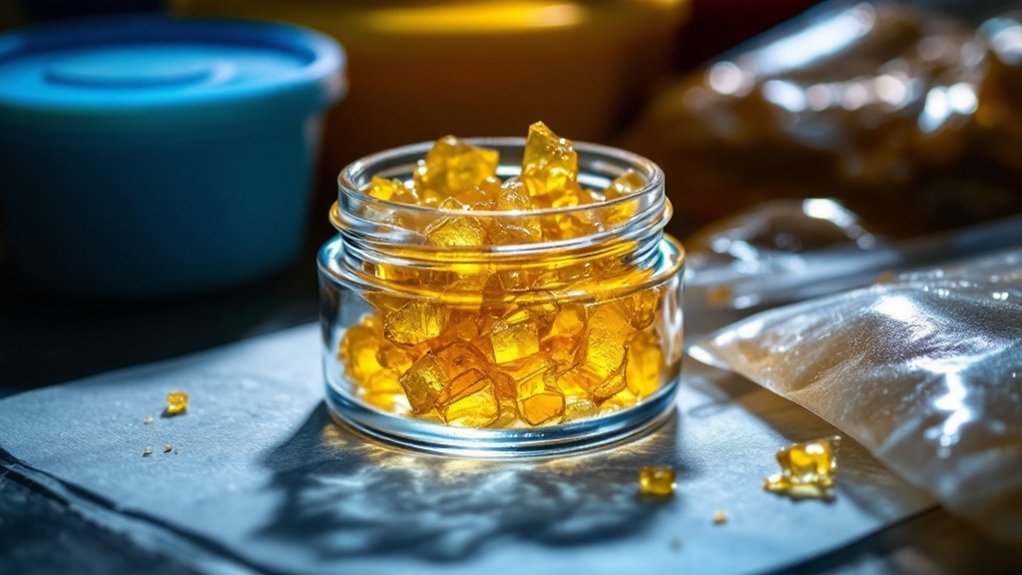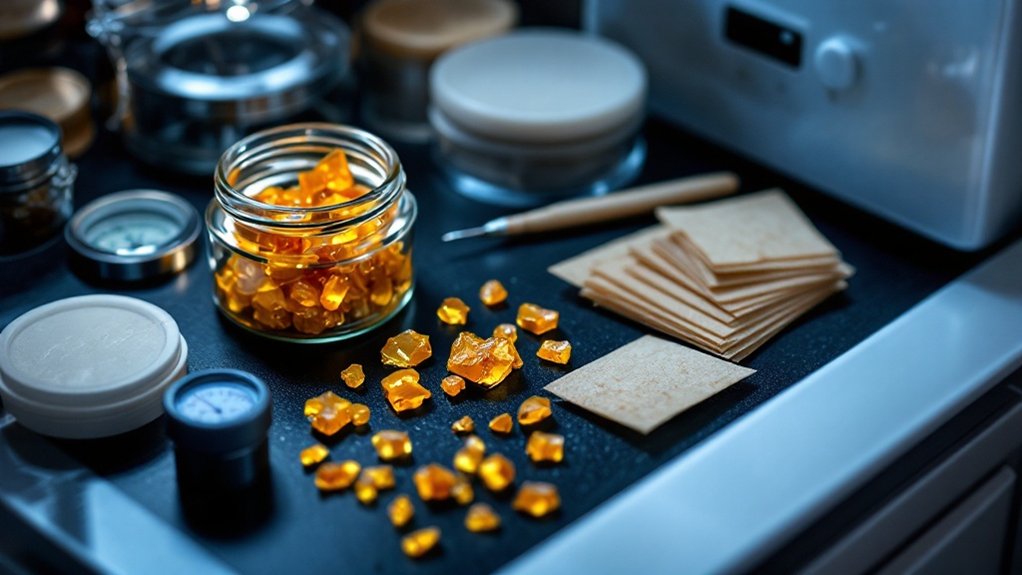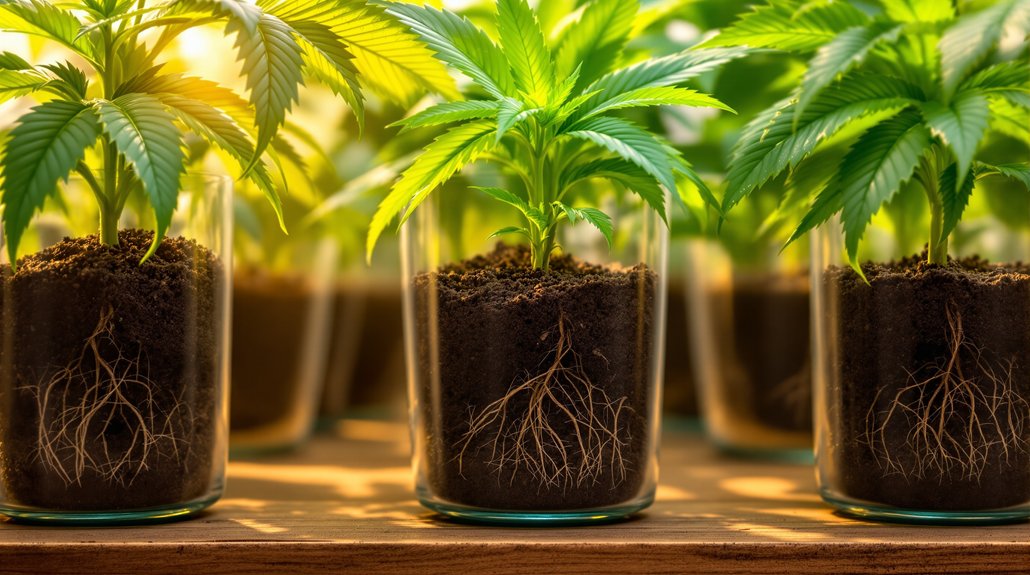To preserve shatter’s potency and consistency, store it in an airtight glass or silicone container away from light, heat, and moisture. Refrigeration is ideal for regular use, while freezing in vacuum-sealed containers works best for long-term storage. Always allow containers to reach room temperature before opening to prevent condensation that can degrade the concentrate. Proper storage techniques prevent oxidation and terpene loss, maintaining the chemical profile that delivers shatter’s distinctive effects and flavor profile.

Preserving the quality of cannabis concentrates requires meticulous attention to environmental factors that can greatly impact their chemical composition over time. Shatter, a particularly delicate concentrate, degrades when exposed to heat, light, air, and moisture. These elements can transform its brittle, glass-like consistency into a syrupy texture while simultaneously reducing its cannabinoid and terpene content.
Temperature management stands as a critical factor in maintaining shatter’s integrity. The ideal storage environment is a cool, stable setting such as a refrigerator, which slows the degradation process considerably. Long-term preservation benefits from freezing the concentrate in airtight, vacuum-sealed containers, though users must allow these containers to reach room temperature before opening to prevent condensation formation. This moisture introduction can prove detrimental to the concentrate’s chemical stability.
Temperature control is paramount—refrigerate for stability or freeze in airtight containers for long-term storage, always allowing proper thawing to prevent damaging condensation.
Light exposure, particularly UV radiation, accelerates THC degradation through a process called photodegradation. This reaction not only diminishes potency but alters the concentrate’s color and consistency. Storing shatter in lightproof containers or completely dark locations effectively mitigates this risk. Even when using transparent glass containers, keeping them in dark places remains essential for maintaining the concentrate’s chemical profile.
Oxidation presents another considerable threat to shatter quality, making airtight containers indispensable for proper storage. Silicone and glass containers with secure lids prevent air exposure, which would otherwise lead to terpene evaporation and cannabinoid deterioration. For maximum preservation, containers should match the amount of shatter being stored to minimize excess air inside. Many concentrate enthusiasts prefer using high-density silicone containers for their non-stick properties and superior durability. Some enthusiasts implement double-sealing techniques using plastic bags or vacuum-sealed pouches for additional protection. However, certain high-purity concentrates may not be compatible with silicone as d-Limonene terpenes can dissolve these materials over time.
Humidity and moisture control requires vigilance, as exposure can foster mold growth and alter the concentrate’s consistency. Areas with fluctuating humidity levels, such as kitchens and bathrooms, should be avoided. For those implementing refrigeration storage, allowing containers to reach ambient temperature before opening prevents condensation formation on the concentrate.
Daily users may find parchment paper wrapping sufficient for short-term storage at room temperature, while those seeking extended preservation should consider vacuum-sealed, freezer-safe containers. Dividing larger quantities into smaller portions prevents repeated thawing and refreezing cycles.
Regardless of storage method, using clean, dry tools when handling shatter minimizes contamination and maintains its pristine condition throughout its usable lifespan.
Frequently Asked Questions
Can Shatter Be Stored in Parchment Paper?
Shatter can be stored in parchment paper for short-term periods of up to one week.
While parchment provides a non-stick surface that prevents the concentrate from adhering to packaging, it offers limited protection against moisture, oxygen, and light exposure.
For medium-term storage extending to several weeks, parchment-wrapped shatter should be placed inside an airtight container.
Long-term storage or freezer preservation requires more robust solutions than parchment paper alone due to risks of brittleness and contaminant exposure.
Does Shatter Lose Potency Over Time?
Shatter does experience potency degradation over time. While it doesn’t technically expire, studies indicate cannabis concentrates can lose approximately 40% of their potency after two years at room temperature.
This degradation process involves THC converting to CBN, resulting in more sedative effects. Environmental factors greatly impact degradation rates, with exposure to light, heat, oxygen, and humidity all accelerating potency loss.
The degradation process manifests through color darkening, texture changes, and diminished effectiveness.
What Temperature Causes Shatter to Degrade?
Shatter begins to degrade above 21°C (70°F), with degradation processes accelerating as temperatures increase.
At this threshold, the chemical structure of cannabinoids and terpenes starts breaking down, resulting in reduced potency and altered consistency.
Higher temperatures exacerbate the degradation by promoting oxidation and molecular restructuring.
The combination of heat with other environmental factors like light and oxygen exposure further destabilizes the compounds, converting THC to less potent CBN and diminishing the product’s overall quality.
How Can You Tell if Shatter Has Gone Bad?
Degraded shatter exhibits several telltale signs of quality loss.
Visual indicators include darkening of the amber color, cloudiness, white spots, or powdery residue on the surface.
Texture changes from a glass-like consistency to sticky, gummy, or taffy-like properties indicate breakdown has occurred.
Users might notice an off-putting odor replacing the natural terpene profile, while potency diminishes as THC degrades.
The formation of mold or visible contamination signals improper storage and renders the product unsafe for consumption.
Is It Safe to Store Different Shatter Strains Together?
Storing different shatter strains together is not recommended due to several preservation concerns.
Cross-contamination can occur when terpenes and cannabinoids transfer between strains, altering their distinctive flavors, aromas, and potency profiles. The unique characteristics of each strain may become compromised through direct contact, creating a muddled sensory experience.
Additionally, strain-specific effects important for medicinal users become unpredictable. Proper isolation using parchment paper and separate airtight glass containers maintains the integrity and intended properties of each individual shatter strain.









